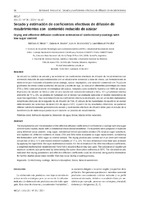Secado y estimación de coeficientes efectivos de difusión de recubrimientos con contenido reducido de azúcar
Drying and effective diffusion coeficient estimation of confectionery coatings with low-sugar content
Date
2021-04-27Author
Meza, Bárbara Erica
Beuter, Daiana Ayelen
Brumovsky, Luis Alberto
Peralta, Juan Manuel
Metadata
Show full item recordAbstract
Se estudió la cinética de secado y se estimaron los coeficientes efectivos de difusión de recubrimientos con contenido reducido de azúcarelaborados con un edulcorante comercial a base de stevia. Las formulaciones se elaboraron por triplicado utilizando cacao amargo, azúcar impalpable, una solución comercial con 7% p/p de glucósidos de steviol como sustitutivo del azúcar y aceite de soja. Se evaluaron diferentes porcentajes de stevia (75% y 50%) como edulcorante en reemplazo del azúcar, tomando como control la muestra con 100% de azúcar. El proceso de secado se llevó a cabo en una estufa con convección natural a 50 (± 1)°C y humedad relativa ambiente de 17 (± 2)%. La pérdida de humedad con el tiempo fue analizada aplicando el modelo matemático de capa fina logarítmico. Para la estimación de los coeficientes efectivos de difusión, se usó un modelo matemático simplificado derivado de la segunda ley de difusión de Fick. El cálculo de las humedades de equilibrio se realizó determinando las isotermas de desorción de agua a 50°C. A partir de los resultados obtenidos, se pudieron obtener satisfactoriamente parámetros de secado y coeficientes efectivos de difusión útiles para el estudio de la transferencia de materia que pueda ocurrir durante un proceso de recubrimiento. The drying kinetics and the estimation of the effective diffusion coefficients of confectionery coatings with low-sugar content were studied, made with a commercial stevia-based sweetener. Formulations were prepared in triplicate using defatted cocoa powder, icing sugar, commercial steviol glycosides solution (7% w/w) as sugar substitute, and soybean oil. Different contents of stevia (75% and 50%) were evaluated as sugar replacement, considering the formulation with 100% sugar as control sample. The drying process was carried out in an oven with natural convection at 50 (± 1)°C and relative ambient humidity of 17 (± 2)%. The loss of moisture over time was analysed by applying the logarithmic thin layer mathematical model. For the estimation of the effective diffusion coefficients, a simplified mathematical model derived from Fick’s second diffusion law was used. The calculation of equilibrium moisture contents was performed by determining the water desorption isotherms at 50°C. The obtained results indicated that drying parameters and effective diffusion coefficients could be obtained, being useful information for further studies about mass transfer that may occur during a coating process.
Collections
The following license files are associated with this item:




